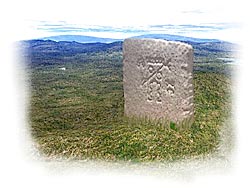
 |
 |
| Home |
| About Orkney |
| History |
| Tradition |
| Folklore |
| Placenames |
| Images |
| Downloads |
| About the Site |
| Contact |
| Links |
| Search Site |
| Awards |
| The Belted Knights of Stove | |
| The Sandwick King Stone
The section that relates to the incognito king combing his hair by a stone brings little to the narrative and instead appears to be a later addition. Could it have been a later "insertion" to conveniently explain the origin of the name of a well-known local landmark? I wonder whether the Sandwick stone's epithet had anything to do with the fabled visit of King James V of Scotland. Instead, could the stone have been associated with a "king" long before the alleged events of the 16th century? The Belted Knights of Stove legend is made up of two, seemingly separate, strands of folklore. The main tale relates how John Kirkness came to be made a knight, while the other casually throws in the fact that there was a "King's stone" in Sandwick at the time. All we really know about this stone is that was around 3.5 feet by 2.25 feet square and was removed, and incorporated into the foundations of a water mill, in the 1850s. But what was this King's Stone? An inauguration stone? For the answer, we need to look into Orkney's pre-Norse culture, and, in particular, the motif of the inauguration, or coronation, stone. These stones were common in Ireland and Western Scotland and were the places where a ruler or chieftain was crowned. In later tradition, the Christian Church "hijacked" the legends and traditions surrounding these stones, so very often these days we find them associated with saints or other holy people. So, was the Sandwick King Stone an inauguration stone? Obviously we can't say for sure - but there are tantalising elements that seem to hint at the possibility. It is tempting, but tenuous, to find parallels in the fact that the discovery of the young man's royalty was closely linked to the King's Stone - his kingship becomes apparent to those watching him as he sat by the stone. Do we have faint echoes of a symbolic "coronation" tradition? Pictish symbols The legend's reference to the king's gold comb is also intriguing. Did the comb motif have some significance, other than being a throwaway element of the story? The symbol of the comb and mirror is common on Pictish symbol stones, which leads us to the Sandwick tradition that a marking on the stone connected it with the king. At no point in the recorded folklore does it actually state that the word "king" was inscribed on the stone, instead we learn it showed a carving (or carvings) representing "king". Were these markings Pictish symbols? Or perhaps there was another 'symbol' that would, at one time, have been widely recognised as representing royalty. Was the stone marked with a footprint? Writing in the second half of the 16th century, the English poet Edmund Spenser remarked that he had seen many "footprint stones" in Ireland. These stones, he wrote, had been used in the inauguration of local chieftains. The most renowned of these was the Lia Fáil - the Stone of Destiny - at the ritual centre of Ireland, Tara. One of the four treasures brought to Ireland by the magical Tuatha Dé Danaan, this stone was said to scream when the true king stood on it. There are numerous other similar stones throughout Ireland and Scotland But what do these Irish legends have to do with Orkney? The Irish connection From Irish records it would appear that the Northern Isles had some significance or connection to the ancient Irish. Their mythology declares that the Tuatha Dé Danaan brought the Lia Fáil to Tara in Ireland from "the Northern Isles" - a place where they had acquired their mystical knowledge and powers. Another apparent connection was noted during the 2002 excavations around Minehowe, in Tankerness. Then it was noted that the Iron Age ritual landscape has more in common with Irish ritual sites, such as Tara, rather than its Scottish counterparts. Although we cannot say with any certainty what this connection was, Irish tradition certainly implies that the islands were connected to Irish royalty by marriage. The Irish chroniclers believed that the Picts arrived in Ireland from Scythia. After being given wives by the Irish, the Picts sailed northwards, where they settled in Orkney. Although this legend is of dubious historical accuracy, does it have any root in truth? Was there a connection - by marriage or otherwise - between Iron Age and Pictish Orkney and Ireland? Whatever the connection with Ireland, footprint stones are not unknown in the Northern Isles, with such stones found in Orkney and Shetland. The best known Orcadian stone is South Ronaldsay's Ladykirk Stone, said to be marked with the footprints of Saint Magnus. So, although it is possible that Sandwick's King's Stone was indeed an inauguration stone, that is about all that can be said. The answers to who used it, and when, are now lost in the mists of time. All that can be said with any certainty is that until the fragments of the stone see the light of day again, we can only indulge in speculation. |
|
